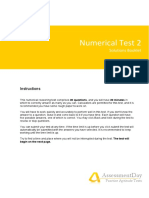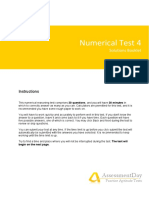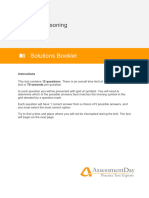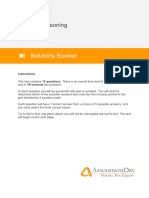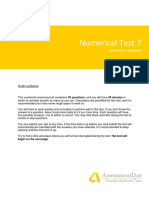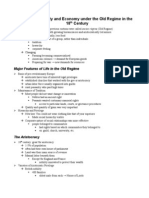VerbalReasoningTest1 Solutions
VerbalReasoningTest1 Solutions
Uploaded by
info_media1Copyright:
Available Formats
VerbalReasoningTest1 Solutions
VerbalReasoningTest1 Solutions
Uploaded by
info_media1Original Description:
Copyright
Available Formats
Share this document
Did you find this document useful?
Is this content inappropriate?
Copyright:
Available Formats
VerbalReasoningTest1 Solutions
VerbalReasoningTest1 Solutions
Uploaded by
info_media1Copyright:
Available Formats
Instructions
This verbal reasoning test comprises 30 questions, and you will have 25 minutes in which to
correctly answer as many as you can.
You will be presented with a passage to read, and a statement about that passage. For each
statement you must select one of the following answers:
True: The statement follows logically from the information contained in the passage.
False: The statement is logically false from the information contained in the passage.
Cannot Say: It is not possible to determine whether the statement is true or false
without further information.
You will have to work quickly and accurately to perform well in this test. If you dont know the
answer to a question, leave it and come back to it if you have time.
Try to find a time and place where you will not be interrupted during the test. When you
are ready, begin the test.
Verbal Test 1
Solutions Booklet
Assessment Day
Practice Aptitude Tests
For personal use only. Unauthorised copying or
distribution in printed, electronic, or any other
form in whole or in part, is prohibited without
prior written permission from AssessmentDay.
Page 2
Document last updated 05-11-2013
AssessmentDay
www.assessmentday.co.uk
Checked shirts are now synonymous with the technology entrepreneur. Whilst
nobody can be attributed with starting the craze, this criss-crossed personal
statement has since been adopted by technology whiz-kids from Facebook founder
Mark Zuckerberg to Twitter co-founder Eva William. The open-necked checked shirt
look is beginning to be emulated by American teenagers. The important question
being asked by fashion retailers is whether this trend will grow beyond its currently
niche audience to the mass market. Fashion trends are fickle and if retailers get it
wrong they are quickly punished through falling revenue. That is why fashion outlet
Dicies often attends social gatherings and exhibitions where they expect to find lots
of young people; their thinking is that if they can observe fashion trends and be
ahead of the curve they will get a larger slice of the retail pie.
Q1 Twitter was founded by more than one person.
True False Cannot say
True - The second sentence says Twitter co-founder Eva William so if Eva was a
co-founder there must have been at least one other person named as a company
founder.
Q2 Mark Zuckerberg started the trend for wearing checked shirts.
True False Cannot say
False - The second sentence tells us that whilst nobody can be attributed with
starting the craze, thishas now been adopted by technology whiz-kids from
Facebook founder Mark Zuckerberg. So firstly the trend cannot be attributed to any
one person, but also important is the fact that the passage tells us Mark Zuckerberg
has since started wearing these shirts.
Q3 Trends in fashion can be said to remain steady over time.
True False Cannot say
False - The first sentence of the second paragraph tells us that Fashion trends are
fickle. If something is fickle, it is not true to say that it is steady; in fact fickle
should be associated with the opposite of stable.
For personal use only. Unauthorised copying or
distribution in printed, electronic, or any other
form in whole or in part, is prohibited without
prior written permission from AssessmentDay.
Page 3
Document last updated 05-11-2013
AssessmentDay
www.assessmentday.co.uk
Q4 Fish stocks in the North Sea are nearly exhausted.
True False Cannot say
Cannot say - The passage tells us only that the EU are seeking to preserve existing
stocks and environmentalists wish to avoid depletion. The passage does not tell us if
fish stocks are near to depletion or indeed if they are plentiful, so we must answer
Cannot Say.
Q5 Some environmental groups think new fish conservation methods are
required.
True False Cannot say
True - The passage states that environmental groups believe existing approaches
are not working and other steps need to be taken. So if measures other than
existing are called for, this must mean new methods are called for.
Q6 Fishermen can be fined for catching too many fish.
True False Cannot say
False - The passage states that fishermen can be fined as soon as the catch is
landed -but not before- so they cannot be fined for catching too many fish.
In an effort to preserve fishing stocks, the European Union uses a quota system to
regulate the amount of fish that can be taken out of the North Sea. This involves
defining the tonnage of the various types of North Sea fish that each EU member
country can take. As soon as the catch is landed - but not before fishermen can
be fined for landing more fish at their port than their quota permits. Each year
fishermen dump thousands of tonnes of fish back into the sea either because they
have reached their quota and dont want to be fined or because the fish are too
small to be caught legally. Some environmental groups feel that existing
approaches are not working since these fish are already dead and throwing them
back serves no real purpose. They believe that other steps need to be taken to
conserve North Sea fishing stocks and avoid depletion.
For personal use only. Unauthorised copying or
distribution in printed, electronic, or any other
form in whole or in part, is prohibited without
prior written permission from AssessmentDay.
Page 4
Document last updated 05-11-2013
AssessmentDay
www.assessmentday.co.uk
Q7 Biofuels can be used to power aircraft.
True False Cannot say
Cannot say - The passage tells us that supporters claim that they are a
alternative to traditional fossil fuels like coal and petroleum. So this tells us what
supporters claim, but not what is necessarily the case.
The passage also tells us that Biofuels are increasingly used in the transportation
sector. So this does not tell us either way if they are used specifically for air travel.
Since the passage does not tell us either way if this statement is definitely true or
definitely false, we must answer Cannot Say.
Q8 Oil from some plants will flow more easily if it is heated.
True False Cannot say
True - The passage says that one type of plant used in the production of biofuels has
its oil extracted and heated to reduce viscosity. Reducing viscosity means making a
liquid less thick and more free-flowing.
Biofuels are now being used worldwide and supporters claim that they are a
sustainable, renewable and cleaner alternative to traditional fossil fuels such as
coal and petroleum, supplies of which are becoming depleted. Biofuels are
increasingly used in the transportation sector. The main producers of biofuels are
in Asia, Europe and America. They can be produced from any carbon source
including landfill gasses and recycled vegetable oil but most of the biofuel
produced around the world is derived from photosynthetic plants grown in Brazil.
The two main types of plant used in production are those high in sugar, which are
fermented to produce ethanol, and those high in oil, which have the oil extracted
and heated to reduce viscosity before the oil is used. Advocates explain that
burning biofuels releases the same amount of CO
2
that the plants took out of the
environment during their growth so there is no net increase in levels of
atmospheric carbon.
For personal use only. Unauthorised copying or
distribution in printed, electronic, or any other
form in whole or in part, is prohibited without
prior written permission from AssessmentDay.
Page 5
Document last updated 05-11-2013
AssessmentDay
www.assessmentday.co.uk
Q9 Ethanol can be produced from photosynthetic plants with high oil content.
True False Cannot say
Cannot say - This is a sneaky one. The passage tells us that plants with high oil
content have the oil extracted and heated to reduce viscosity before the oil is used.
The passage also tells us about plants which are high in sugar which are fermented
to produce ethanol. However the passage does not tell us specifically if plants with
high oil content can or cannot be used to produce ethanol.
For personal use only. Unauthorised copying or
distribution in printed, electronic, or any other
form in whole or in part, is prohibited without
prior written permission from AssessmentDay.
Page 6
Document last updated 05-11-2013
AssessmentDay
www.assessmentday.co.uk
Q10 Flexible working arrangements are conducive to better job satisfaction for
employees.
True False Cannot say
True - This statement is essentially a summary of the third sentence: Employees
able to adopt flexible working are better able to balance work and family
commitments and are therefore happier at work, experiencing greater job
satisfaction.
Q11 Employees are legally entitled to work flexible hours if they request to do so.
True False Cannot say
False - The passage states that All employees have a statutory right to request
flexible working arrangements; the law extends no further than insisting employers
consider and respond to these requests within a predefined timescale. So the
passage is telling us that the law requires the employer to consider the employees
request but that is as far as the law goes; i.e. it does not go as far as saying they
have to honour the request.
Many businesses now recognise that there are wide-ranging benefits to be
gained from offering their workforce flexible working arrangements. These
arrangements can include being able to work from home, job sharing, part-time
working and being able to choose when to complete agreed hours, for example
through working fewer but longer days, or working flexitime. Employees able to adopt
flexible working are better able to balance work and family commitments and are
therefore happier at work, experiencing greater job satisfaction. They are also more
motivated and less likely to leave which is important because staff recruitment costs
are not insignificant to businesses. For businesses, they reap the benefits through
productivity increases, and greater cost-effectiveness. Customers can benefit too as
businesses are better able to react quickly to changes in the market. All employees
have a statutory right to request flexible working arrangements; the law extends no
further than insisting employers consider and respond to these requests within a
predefined timescale.
For personal use only. Unauthorised copying or
distribution in printed, electronic, or any other
form in whole or in part, is prohibited without
prior written permission from AssessmentDay.
Page 7
Document last updated 05-11-2013
AssessmentDay
www.assessmentday.co.uk
Q12 Employers may save on recruitment costs if they introduce flexible working
hours.
True False Cannot say
True - The passage tells us that by adopting flexible working hours, staff are more
motivated and less likely to leave. We are also told that Staff recruitment costs are
not insignificant to businesses. So the passage says that by improving staff
retention, businesses are more likely to save money on recruitment costs by adopting
flexible working hours.
For personal use only. Unauthorised copying or
distribution in printed, electronic, or any other
form in whole or in part, is prohibited without
prior written permission from AssessmentDay.
Page 8
Document last updated 05-11-2013
AssessmentDay
www.assessmentday.co.uk
Q13 There is no legislation covering discrimination at work so employers have to
develop their own ways of preventing it.
True False Cannot say
False - The first sentence tells us that most forms of discrimination in the workplace
have been outlawed. So even though not all forms of discrimination have been
outlawed (made illegal), it is not true to say that no legislation exists.
Q14 Males are less likely to experience the glass ceiling effect than females.
True False Cannot say
Cannot say - The third sentence tells us what the glass ceiling is and the fourth
sentence tells us: Originally coined to illustrate the hidden use of sexual
discrimination against women in professional environments, it is now used to
describe any form of discrimination. So if we know it covers all sorts of discrimination
and the passage doesnt go on to say if females are more likely to suffer than males,
we cannot say for sure whether this statement is true or false, so we have to answer
Cannot Say.
While most forms of discrimination in the workplace have been outlawed,
discrimination or bias against some employees seeking career advancement still
happens. This discrimination is both unwritten and unacknowledged. A glass
ceiling is the term used to describe this type of discrimination and refers to the
invisible barrier that people hit when they try to progress beyond a certain level in
some businesses and organisations. Originally coined to illustrate the hidden use of
sexual discrimination against women in professional environments, it is now used to
describe any form of discrimination, such as racism or ageism, which prevents
qualified or experienced employees reaching even basic levels within their
organisation. Some reports and studies now suggest that change is happening and
that cracks are beginning to appear in the glass. The studies also claim however
that change is happening slowly and that the cracks are small.
For personal use only. Unauthorised copying or
distribution in printed, electronic, or any other
form in whole or in part, is prohibited without
prior written permission from AssessmentDay.
Page 9
Document last updated 05-11-2013
AssessmentDay
www.assessmentday.co.uk
Q15 A glass ceiling can prevent qualified people from getting to the top of their
field.
True False Cannot say
True - The passage tells us that the glass ceiling describes discrimination which is
both unwritten and unacknowledged and also that the term applies to any form of
discrimination, such as racism or ageism, which prevents qualified or
experienced employees reaching even basic levels within their organisation. So it is
indeed possible that a glass ceiling can prevent a qualified person getting to the top
of their field.
For personal use only. Unauthorised copying or
distribution in printed, electronic, or any other
form in whole or in part, is prohibited without
prior written permission from AssessmentDay.
Page 10
Document last updated 05-11-2013
AssessmentDay
www.assessmentday.co.uk
The Flying Shuttle and the Spinning Jenny are two early 18th century British
inventions that revolutionised the textile industry. They increased productivity by
automating some key processes thereby reducing the amount of manual operation
needed. The Flying Shuttle, for example, raised the productivity of manual weaving
by around 50 percent by returning the shuttle automatically meaning that one worker
could do the work that previously had to been done by two. The Spinning Jenny
invented a couple of decades later similarly automated processes allowing one
spinner to do more. Reducing the amount of manual intervention needed for these
tasks also meant that they were more suitable for adaptation to mechanical power
such as waterpower and steam which had become the new means of propulsion
shortly before their invention.
Q16 Automating the production process of weaving was a necessary precursor to
the invention of steam power.
True False Cannot say
False - The passage tells us that automating these weaving processes meant that
they were better suited to steam power, which had become the new means of
propulsion shortly before their invention So if steam power was developed before
automated weaving, the automation cannot have been a necessary precursor.
Q17 The invention of the Flying Shuttle and the Spinning Jenny led to job losses
in the textile industry
True False Cannot say
Cannot say - Whilst this might be an assumption one makes, the passage does not
say this explicitly. For example it would be that the same workforce took on different
jobs within the textile industry or that they helped produce an increase in output. The
passage does not tell whether these inventions did or didnt lead to job losses, so we
must answer Cannot Say.
For personal use only. Unauthorised copying or
distribution in printed, electronic, or any other
form in whole or in part, is prohibited without
prior written permission from AssessmentDay.
Page 11
Document last updated 05-11-2013
AssessmentDay
www.assessmentday.co.uk
Q18 The textile industry was heavily dependent on manual labour before the
arrival of the Flying Shuttle and Spinning Jenny.
True False Cannot say
Cannot say - The passage talks about these inventions reducing the manual labour
required, but it does not tell us what levels of manual labour were required before (or
after for that matter) the Flying Shuttle and Spinning Jenny came along. Since this
information is not covered in the passage, we have to answer Cannot Say.
For personal use only. Unauthorised copying or
distribution in printed, electronic, or any other
form in whole or in part, is prohibited without
prior written permission from AssessmentDay.
Page 12
Document last updated 05-11-2013
AssessmentDay
www.assessmentday.co.uk
Q19 Most local authorities have end-to-end recycling facilities
True False Cannot say
Cannot say - The passage tells us that Many local authorities have designed and
implemented full end-to-end recycling programmes, however the passage does not
tell us if these are the majority or the minority, so we have to answer Cannot Say.
Q20 Some people say that recycling is a wasteful use of resources.
True False Cannot say
True - The last sentence of the passage says that some critics counter-claim that
recycling actually consumes more resources than it saves. Consuming more
resources than it saves would considered as being wasteful, so the statement is true.
Proponents of recycling are adamant that we must preserve the worlds
precious natural resources by reducing our consumption of new raw materials.
They say that to accomplish this all we need to do is to reuse or recycle many
materials that traditionally would be thrown away and end up in landfill sites. Many
local authorities have designed and implemented full end-to-end recycling
programmes to help encourage recycling. A critical factor in the success of any
waste management and recycling programme is the ability to clearly communicate
waste disposal and depositing policy to the public. The majority of people are
willing to participate, but they are more likely to participate if they can easily
understand what goes where. They are also less likely to make errors and put
something in the wrong place, which can cause costly problems. Supporters claim
that the more we recycle the less it costs, however some critics counter-claim that
recycling actually consumes more resources than it saves and in the long-run is
doing more harm than good.
For personal use only. Unauthorised copying or
distribution in printed, electronic, or any other
form in whole or in part, is prohibited without
prior written permission from AssessmentDay.
Page 13
Document last updated 05-11-2013
AssessmentDay
www.assessmentday.co.uk
Q21 Most of the public are reluctant to participate in recycling because they do
not know what goes where.
True False Cannot say
False - The fifth sentence tells us the majority of people are willing to participate, but
are more likely to participate if they can easily understand what goes where. So we
are told that the majority of the public are willing to participate in recycling. The
second part of the statement about not knowing what goes where is not important
since we have already established that the majority of people are willing to recycle
and therefore that the statement is false.
For personal use only. Unauthorised copying or
distribution in printed, electronic, or any other
form in whole or in part, is prohibited without
prior written permission from AssessmentDay.
Page 14
Document last updated 05-11-2013
AssessmentDay
www.assessmentday.co.uk
Q22 The presence of ice in these debris-covered formations would be the first
discoveries of ice on Mars.
True False Cannot say
False - The fourth sentence tells us There are other known deposits of ice at the
polar caps where temperatures are much lower. So we are told that the discoveries
being reported are not the first instances of ice on Mars.
Q23 NASA believes that there could be enough water on Mars to support human
life.
True False Cannot say
Cannot say - The passage does not tell us about NASAs view on whether Mars has
enough water to support human life; the passage says only some scientists believe
that there could be enough water held in these formations to support humans in
future Mars missions. We are not told whether these scientists are from NASA or
not.
Q24 Radar technology existed prior to the 1980s.
True False Cannot say.
True - The first sentence tells us that radar images were used as far back as the
1970s, so radar technology must have existed in the 1980s.
Some scientists now claim that the low, wide debris-covered formations first
observed on radar images of Mars as far back as the 1970s are in fact glaciers
around 1km thick. The large formations were first seen on images sent back by
NASAs Viking orbiters. There are many similar apron-shaped formations dotted
all over the Martian landscape but the latest reconnaissance images from Mars
have lead some scientists to believe that the bigger rounded slopes and ridges
have features which suggest they were formed by a flow of thick ice-covered
rubble. There are other known deposits of ice at the polar caps where
temperatures are much lower. These newest discoveries are at much lower
latitudes than those previously known about and some scientists believe that
there could be enough water held in these formations to support humans in
future Mars missions.
For personal use only. Unauthorised copying or
distribution in printed, electronic, or any other
form in whole or in part, is prohibited without
prior written permission from AssessmentDay.
Page 15
Document last updated 05-11-2013
AssessmentDay
www.assessmentday.co.uk
Q25 Buildings cause 45% of all the carbon emissions in the UK.
True False Cannot say
Cannot say - The second sentence tells us that Buildings account for 45% of all UK
greenhouse gas emissions such as carbon dioxide and methane. So dont be caught
out; greenhouse gas emissions can include carbon and can include methane, or
other greenhouse gasses. But we are not told the makeup of greenhouse gas
emissions emitted from buildings. Many greenhouse gasses are not carbon based
(water vapour as an example). But since we are not told by the article, we cannot say
for sure.
Q26 Energy efficiency legislation for new construction is more onerous than for
existing buildings.
True False Cannot say
Cannot say - Whilst the passage explains how it would be easier to legislate more
heavily on new construction than for existing buildings, the passage does not tell us
what the current level of legislation is for each category.
Construction companies have to deal with a mountain of energy efficiency
legislation as governments try to move to a low-carbon future. Buildings
account for 45% of all UK greenhouse gas emissions such as carbon dioxide
and methane, so the drive for new energy efficient building stock is
understandable. However it is important to remember that an estimated 70% of
existing buildings will still be in use by 2080, so the focus on new-build is
perhaps misguided. Some people claim that the low-hanging fruit is to be found
by spending time and effort up-rating the efficiency of existing building stock.
Whilst policy makers are aware of the huge potential of reducing carbon
emissions by writing legislation on existing buildings, they admit that this would
involve more heavy-handed intervention and public resistance than if they
levelled their sights on the construction of new buildings. All new building
construction requires approval from authorities and regulating bodies, so this
naturally lends itself to an expansion of rules on energy and carbon emissions.
As with most things, the issue comes down to cost and political convenience.
For personal use only. Unauthorised copying or
distribution in printed, electronic, or any other
form in whole or in part, is prohibited without
prior written permission from AssessmentDay.
Page 16
Document last updated 05-11-2013
AssessmentDay
www.assessmentday.co.uk
Q27 The construction of some new buildings is exempt from legislation.
True False Cannot say
False - The sixth sentence says All new building construction requires approval from
authorities and regulating bodes. So according to the passage it is not true that
some building construction is exempt.
For personal use only. Unauthorised copying or
distribution in printed, electronic, or any other
form in whole or in part, is prohibited without
prior written permission from AssessmentDay.
Page 17
Document last updated 05-11-2013
AssessmentDay
www.assessmentday.co.uk
Q28 Wildfires can be beneficial to the natural environment.
True False Cannot say
True - The penultimate sentence tells us that wildfires can play an important role in
the ecosystem returning beneficial nutrients to the ground and killing disease. So
we are told that there can be some benefits to the natural environment in certain
circumstances.
Q29 One quarter of wildfires are started naturally.
True False Cannot say
False - The fourth sentence tells us that humans start eighty per cent of all wildfires.
So if humans are responsible for 80% of wildfires, it cannot be true that 25% are
started naturally.
Q30 In the USA there are typically 10,000 wildfires each month.
True False Cannot say
Cannot say - The passage says that there is an average annual rate of 120,000
wildfires, but it does not state that these are evenly distributed through the year.
Therefore one cannot divide this figure by 12 to get an average monthly figure (e.g.
perhaps 50% happen in July or August). Since we are not told the monthly figure, we
have to answer Cannot Say.
In the USA there are on average 2 million hectares of land cleared by 120,000
wildfires per annum. These uncontrolled blazes can travel at up to 23 kilometres per
hour and destroy everything in their path. Prolonged drought and dry conditions
produce tinder-dry vegetation that can be ignited by a single spark and can rapidly
become a raging inferno when fed by hot dry winds. The sad fact is that humans
start eighty per cent of all wildfires, either intentionally or accidentally. Embers from
campfires and discarded cigarettes are common causes. Nature plays its part too
with fires starting via lightning and even the direct heat of the sun. Naturally-
occurring wildfires can play an important role in the ecosystem of some forest
environments since the fires destroy dead or rotting vegetable matter, returning
beneficial nutrients to the ground and killing disease. There are even some seeds
that can only germinate if they have been heat-treated by such fires.
For personal use only. Unauthorised copying or
distribution in printed, electronic, or any other
form in whole or in part, is prohibited without
prior written permission from AssessmentDay.
Page 18
Document last updated 05-11-2013
AssessmentDay
www.assessmentday.co.uk
-- End of Test --
You might also like
- London Sample Maths TestDocument7 pagesLondon Sample Maths TestTomer BrenerNo ratings yet
- History of TextileDocument6 pagesHistory of TextileMarc Christian M BaguioNo ratings yet
- Numerical Test 10: AssessmentdayDocument33 pagesNumerical Test 10: AssessmentdayThanh Phu TranNo ratings yet
- VerbalReasoningTest11 SolutionsDocument13 pagesVerbalReasoningTest11 SolutionsjoshikaNo ratings yet
- TQ Elements Verbal Guide NewDocument8 pagesTQ Elements Verbal Guide NewBalkan KhilmiNo ratings yet
- NumericalReasoningTest1 SolutionsDocument0 pagesNumericalReasoningTest1 Solutionsinfo_media1No ratings yet
- PWC Numerical Reasoning Tests Mock - 3 Question Only 32rgs PDFDocument20 pagesPWC Numerical Reasoning Tests Mock - 3 Question Only 32rgs PDFElla LucaNo ratings yet
- Tutorial Letter 101/0/2023: Year ModuleDocument16 pagesTutorial Letter 101/0/2023: Year Modulesiphelele100% (1)
- Test Partnership Numerical Reasoning Test 3: AssessmentdayDocument20 pagesTest Partnership Numerical Reasoning Test 3: AssessmentdayThanh Phu TranNo ratings yet
- Verbal Test 1: Assessment DayDocument18 pagesVerbal Test 1: Assessment DayrofiqNo ratings yet
- Numerical ReasoningDocument8 pagesNumerical Reasoninggiri prasad madderlaNo ratings yet
- Numerical Reasoning Percentage Increase and Decrease - Graduatewings - CoDocument1 pageNumerical Reasoning Percentage Increase and Decrease - Graduatewings - Cocorporateboy36596No ratings yet
- Practice Numerical Reasoning Test SolutionDocument23 pagesPractice Numerical Reasoning Test Solutioneslam heroNo ratings yet
- 489 SHL QuestionsDocument1 page489 SHL QuestionsFarahKhan0% (1)
- Introduction To Technical Management ProcessesDocument16 pagesIntroduction To Technical Management Processesinfo_media1No ratings yet
- Merged Verbal Sol PDFDocument51 pagesMerged Verbal Sol PDFIfelayomiNo ratings yet
- Verbal Reasoning Test2 SolutionsDocument12 pagesVerbal Reasoning Test2 SolutionsALIEVALINo ratings yet
- Verbal Reasoning Test2 SolutionsDocument10 pagesVerbal Reasoning Test2 SolutionsmissepNo ratings yet
- Test Partnership Numerical Reasoning Test 3: AssessmentdayDocument20 pagesTest Partnership Numerical Reasoning Test 3: AssessmentdayThanh Phu TranNo ratings yet
- Logical Reasoning Test 1: AssessmentdayDocument9 pagesLogical Reasoning Test 1: AssessmentdaykemsmartaNo ratings yet
- Test 15 SolutionsDocument31 pagesTest 15 SolutionsNguyệt LinhNo ratings yet
- Numerical Reasoning Test2 QuestionsDocument11 pagesNumerical Reasoning Test2 QuestionsvarshnnhNo ratings yet
- NumericalReasoningTest2 SolutionsDocument32 pagesNumericalReasoningTest2 SolutionsGanesh UnNo ratings yet
- How To Work Out Ratios in Psychometric Tests - Graduatewings - CoDocument1 pageHow To Work Out Ratios in Psychometric Tests - Graduatewings - Cocorporateboy36596No ratings yet
- NumericalReasoningTest4 SolutionsDocument31 pagesNumericalReasoningTest4 SolutionsErika HasyimNo ratings yet
- VerbalReasoningTest6 SolutionsDocument13 pagesVerbalReasoningTest6 Solutionsjdaley1991No ratings yet
- Practice Test 12: Numerical ReasoningDocument11 pagesPractice Test 12: Numerical ReasoningaddeNo ratings yet
- Numerical Test 5 SolutionsDocument16 pagesNumerical Test 5 Solutionslawrence ojuaNo ratings yet
- LogicalReasoningTest1 SolutionsDocument14 pagesLogicalReasoningTest1 Solutionsmohamedabdalbaky10No ratings yet
- Numerical Test 4 QuestionsDocument9 pagesNumerical Test 4 QuestionsDaniel DamboNo ratings yet
- InductiveReasoningTest12 SolutionsDocument26 pagesInductiveReasoningTest12 SolutionsMohamed MagdyNo ratings yet
- Verbal Reasoning Test2 SolutionsDocument12 pagesVerbal Reasoning Test2 SolutionsZeeshanNo ratings yet
- LogicalReasoningTest3 SolutionsDocument14 pagesLogicalReasoningTest3 Solutionsmohamedabdalbaky10No ratings yet
- NumericalCriticalReasoningTest3 SolutionsDocument23 pagesNumericalCriticalReasoningTest3 SolutionssjNo ratings yet
- SJT3 AnswersDocument28 pagesSJT3 Answerstd342003No ratings yet
- InductiveReasoningTest4 QuestionsDocument31 pagesInductiveReasoningTest4 Questionsraul yondoNo ratings yet
- Test Partnership Numerical Reasoning Test 2: AssessmentdayDocument20 pagesTest Partnership Numerical Reasoning Test 2: AssessmentdayThanh Phu TranNo ratings yet
- Numerical Test 1 SolutionsDocument16 pagesNumerical Test 1 SolutionsBARUWA tomiNo ratings yet
- Verbal Reasoning Test2 QuestionsDocument11 pagesVerbal Reasoning Test2 Questionssnehatyagi100% (1)
- Numerical Test 7: AssessmentdayDocument32 pagesNumerical Test 7: AssessmentdayTaxHaven AngelsNo ratings yet
- Preparation Guide For Mechanical Reasoning TestsDocument4 pagesPreparation Guide For Mechanical Reasoning TestschevypickupNo ratings yet
- Verbal Test 9: Assessment DayDocument13 pagesVerbal Test 9: Assessment DayGanesh UnNo ratings yet
- Numerical Reasoning Test1 SolutionsDocument32 pagesNumerical Reasoning Test1 SolutionsJonson CaoNo ratings yet
- Psychometric Test On 22 July 2021 P2P - 2022Document23 pagesPsychometric Test On 22 July 2021 P2P - 2022HARSHIL SHAHNo ratings yet
- Numerical Test 6: AssessmentdayDocument36 pagesNumerical Test 6: AssessmentdayTaxHaven Angels100% (1)
- InductiveReasoningTest1 SolutionsDocument31 pagesInductiveReasoningTest1 SolutionsSong ToànNo ratings yet
- Read The Mind of SBR Marker Part2Document21 pagesRead The Mind of SBR Marker Part2ANTHONYC CHILWESANo ratings yet
- Preparation Guide Diagrammatic Analysis DA INTE SavilleDocument4 pagesPreparation Guide Diagrammatic Analysis DA INTE SavilleJohn StokesNo ratings yet
- Verbal Reasoning Test1 QuestionsDocument0 pagesVerbal Reasoning Test1 QuestionsSoonyam0% (1)
- LogicalReasoningTest1 QuestionsDocument6 pagesLogicalReasoningTest1 QuestionsKoushik SNo ratings yet
- VerbalReasoningTest1 SolutionsDocument16 pagesVerbalReasoningTest1 SolutionsMohamed MagdyNo ratings yet
- Numerical Test 5: AssessmentdayDocument31 pagesNumerical Test 5: AssessmentdaySong ToànNo ratings yet
- E&YDocument11 pagesE&YPriyanka RadhaNo ratings yet
- Numerical Test 9: AssessmentdayDocument31 pagesNumerical Test 9: AssessmentdayTaxHaven AngelsNo ratings yet
- TaxOverviewBrochure 2021 KPMGDocument16 pagesTaxOverviewBrochure 2021 KPMGPrathibha KarthikeyanNo ratings yet
- Inductive Reasoning Practice Test 1: AssessmentdayDocument11 pagesInductive Reasoning Practice Test 1: AssessmentdaySimona BalanNo ratings yet
- SHL Test GuideDocument1 pageSHL Test GuideOscar G.No ratings yet
- 1698010-Investment BankingDocument5 pages1698010-Investment BankingPrachi MishraNo ratings yet
- Algae Biofuel ThesisDocument8 pagesAlgae Biofuel Thesisqigeenzcf100% (2)
- HttpsDocument6 pagesHttpsChi Bùi Thị KimNo ratings yet
- Research Paper On BP Oil SpillDocument4 pagesResearch Paper On BP Oil Spillefdvje8d100% (1)
- South Sea Bubble Refers To The Speculation Mania That Ruined ManyDocument7 pagesSouth Sea Bubble Refers To The Speculation Mania That Ruined ManyPuneet GargNo ratings yet
- New Optional Energy! How To Put The Energy to Use for TomorrowFrom EverandNew Optional Energy! How To Put The Energy to Use for TomorrowNo ratings yet
- VerbalComprehensionTest1 SolutionsDocument0 pagesVerbalComprehensionTest1 Solutionsinfo_media1No ratings yet
- 05 Test Bank For Business FinanceDocument46 pages05 Test Bank For Business FinanceBabatunde Victor AjalaNo ratings yet
- Name: - Date: - Writing To Inform Rubric AssignmentDocument1 pageName: - Date: - Writing To Inform Rubric Assignmentinfo_media1No ratings yet
- Wa0003.Document5 pagesWa0003.xyzNo ratings yet
- Industrialisatiion One MarkersDocument25 pagesIndustrialisatiion One MarkersMannat GroverNo ratings yet
- Spinning Jenny: ClothDocument11 pagesSpinning Jenny: ClothJopay GagatigaNo ratings yet
- CH 25 Sec 1 - The Beginnings of IndustrializationDocument6 pagesCH 25 Sec 1 - The Beginnings of IndustrializationMrEHsiehNo ratings yet
- InventionstcDocument1 pageInventionstcapi-377235825No ratings yet
- The Industrial Revolution in Great BritainDocument17 pagesThe Industrial Revolution in Great BritainAnonymous hVV6Zk0No ratings yet
- 6.5 Artificial Intelligence - CommentsDocument1 page6.5 Artificial Intelligence - CommentsEllson LinNo ratings yet
- The Inventions of Industrial RevolutionDocument15 pagesThe Inventions of Industrial RevolutionSara QayyumNo ratings yet
- 7 The History of ClothesDocument6 pages7 The History of ClothesKaren BaloloyNo ratings yet
- 2031 Cksvim Priyank SipDocument66 pages2031 Cksvim Priyank Sipjpsingh75No ratings yet
- The Indian Forest Under British RajDocument26 pagesThe Indian Forest Under British RajKovid VermaNo ratings yet
- Industrial RevolutionDocument44 pagesIndustrial RevolutionRina100% (2)
- British Enclosure MovementDocument7 pagesBritish Enclosure MovementBiancaNo ratings yet
- World Textiles British TextilesDocument25 pagesWorld Textiles British Textilesadarsh murali0% (1)
- Textiles Year 7 Homework Booklet Homework and End of Module Test With AnswersDocument33 pagesTextiles Year 7 Homework Booklet Homework and End of Module Test With AnswersRobert MinshallNo ratings yet
- Western Heritage Chapter 15: Society and Economy Under The Old Regime in The 18th CenturyDocument12 pagesWestern Heritage Chapter 15: Society and Economy Under The Old Regime in The 18th Centuryelialt100% (5)
- Why Industrial Revolution Began in Great BritainDocument9 pagesWhy Industrial Revolution Began in Great BritainMohd GulzarNo ratings yet
- Outline: 2.1. The Roots of The Industrial RevolutionDocument9 pagesOutline: 2.1. The Roots of The Industrial RevolutionCristina Hernandez ClaveroNo ratings yet
- ENGLISH Use in Textile EngineeringDocument63 pagesENGLISH Use in Textile EngineeringDhrubo Adhikary100% (1)
- Inventions and Their Inventors: Industrial RevolutionDocument3 pagesInventions and Their Inventors: Industrial RevolutionsiyaNo ratings yet
- 13 Inventions - Docx HistoryDocument13 pages13 Inventions - Docx HistoryMohammed Hashim AhmedNo ratings yet
- Industrial RevolutionDocument36 pagesIndustrial RevolutionRichbob DenfordNo ratings yet
- Industrila RevolutionDocument26 pagesIndustrila RevolutionAjay Pratap SinghNo ratings yet
- Concept of Industrial EngineeringDocument31 pagesConcept of Industrial EngineeringvishnuvardhinikjNo ratings yet
- Weavers, Iron Smelters and Factory OwnersDocument28 pagesWeavers, Iron Smelters and Factory Ownersptv7105No ratings yet
- Toefl 5lb 1ed Chapter23 PDFDocument156 pagesToefl 5lb 1ed Chapter23 PDFkomet study abroadNo ratings yet
- THE AGE OF iNDUSTRIALISATION - AssignmentDocument9 pagesTHE AGE OF iNDUSTRIALISATION - Assignmentsamkitjain312008No ratings yet
- Cambridge 19 Reading ParaphraseDocument52 pagesCambridge 19 Reading ParaphraseallawhaalzarqatechnicalserviceNo ratings yet
- Industrial Revolution Notes For Class 8Document11 pagesIndustrial Revolution Notes For Class 8Yamini PurohitNo ratings yet






















